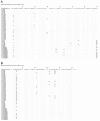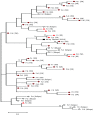The Association of Substitutions in the Hepatitis C Virus Subtype 1b Core Gene and IL28B Polymorphisms With the Response to Peg-IFNα-2a/RBV Combination Therapy in Azerbaijani Patients
- PMID: 27313635
- PMCID: PMC4908614
- DOI: 10.5812/hepatmon.35597
The Association of Substitutions in the Hepatitis C Virus Subtype 1b Core Gene and IL28B Polymorphisms With the Response to Peg-IFNα-2a/RBV Combination Therapy in Azerbaijani Patients
Abstract
Background: The hepatitis C virus (HCV) infection has been identified as a leading cause of progressive liver diseases worldwide. Despite new treatment strategies, pegylated interferon alfa-2a (Peg-IFNα-2a), in combination with ribavirin (RBV), still represents the gold standard of therapy for hepatitis C in developing countries.
Objectives: The aim of this study was to investigate the association of substitutions in the HCV subtype 1b (HCV-1b) core protein and the rs12979860 polymorphism in the interleukin 28B gene (IL28B) with the response to Peg-IFNα-2a/RBV combination therapy in Azerbaijani patients.
Patients and methods: A total of fifty-one chronically HCV-1b-infected Azerbaijani patients were enrolled in this cross-sectional study from March 2010 to June 2015. After RNA extraction from pre-treatment plasma, the core region of the HCV genome was amplified using the nested reverse transcription (RT) polymerase chain reaction (PCR) method, followed by standard sequencing. In addition, genomic DNA was extracted from peripheral blood mononuclear cell (PBMC) specimens, and the rs12979860 single nucleotide polymorphism (SNP) was identified using a PCR-restriction fragment length polymorphism (PCR-RFLP) assay.
Results: In this study, a significant association was observed between the non-responders and relapsers to antiviral therapy and substitutions in the HCV-1b core region at positions 43 (R43K, P = 0.047), 70 (R70Q, P < 0.001), 91 (M91L, P = 0.037), and 106 (S106N, P = 0.018). Concerning the IL28B polymorphism, the results showed that sustained virological response was significantly associated with homozygous CC patients (P = 0.009) as compared with other genotypes, while homozygous TT subjects were associated with HCV relapse after therapy (P = 0.006).
Conclusions: The data of the present study suggest that amino acid substitutions at position 43, 70, 91, and 106 in the HCV-1b core protein are correlated with the response to the Peg-IFNα-2a/RBV treatment in Azerbaijani patients with chronic hepatitis C. Moreover, host genetic polymorphisms, such as those of the IL28B locus, might be useful for predicting the responsiveness to Peg-IFNα-2a/RBV combination therapy against HCV.
Keywords: Core Protein; Hepatitis C Virus; IL28B; Pegylated Interferon; Polymorphisms; Ribavirin.
Conflict of interest statement
Figures


Similar articles
-
Mutations in the NS5A gene of hepatitis C virus subtype 1b and response to peg-IFNα-2a/RBV combination therapy in Azerbaijani patients.Arch Virol. 2014 Nov;159(11):2893-9. doi: 10.1007/s00705-014-2133-0. Epub 2014 Aug 20. Arch Virol. 2014. PMID: 25139545
-
The complete title: The effect of interleukin-28B rs12979860 polymorphism on the therapeutic response of Moroccan patients with chronic hepatitis C.Gene. 2015 Aug 15;568(1):31-4. doi: 10.1016/j.gene.2015.05.010. Epub 2015 May 7. Gene. 2015. PMID: 25958342
-
Polymorphism of the IL28B gene (rs8099917, rs12979860) and virological response of Pakistani hepatitis C virus genotype 3 patients to pegylated interferon therapy.Int J Infect Dis. 2015 Jan;30:91-7. doi: 10.1016/j.ijid.2014.09.021. Epub 2014 Nov 20. Int J Infect Dis. 2015. PMID: 25462177
-
Polymorphism Near the Interleukin-28B Gene and Anti-Hepatitis C Viral Response.J Clin Transl Hepatol. 2013 Sep;1(1):39-44. doi: 10.14218/JCTH.2013.005XX. Epub 2013 Sep 15. J Clin Transl Hepatol. 2013. PMID: 26357605 Free PMC article. Review.
-
A Synopsis of Hepatitis C Virus Treatments and Future Perspectives.Curr Issues Mol Biol. 2023 Oct 11;45(10):8255-8276. doi: 10.3390/cimb45100521. Curr Issues Mol Biol. 2023. PMID: 37886964 Free PMC article. Review.
Cited by
-
The Presence of Autoantibodies to Cytoplasmic Rod and Ring Particles in the Serum of Patients with Chronic Hepatitis C Virus Infection.Hepat Mon. 2016 Dec 11;16(12):e42388. doi: 10.5812/hepatmon.42388. eCollection 2016 Dec. Hepat Mon. 2016. PMID: 28123444 Free PMC article.
References
-
- Alavian SM, Tabatabaei SV, Keshvari M, Behnava B, Miri SM, Elizee PK, et al. Peginterferon alpha-2a and ribavirin treatment of patients with haemophilia and hepatitis C virus infection: a single-centre study of 367 cases. Liver Int. 2010;30(8):1173–80. doi: 10.1111/j.1478-3231.2010.02296.x. - DOI - PubMed
LinkOut - more resources
Full Text Sources
Other Literature Sources
Molecular Biology Databases
